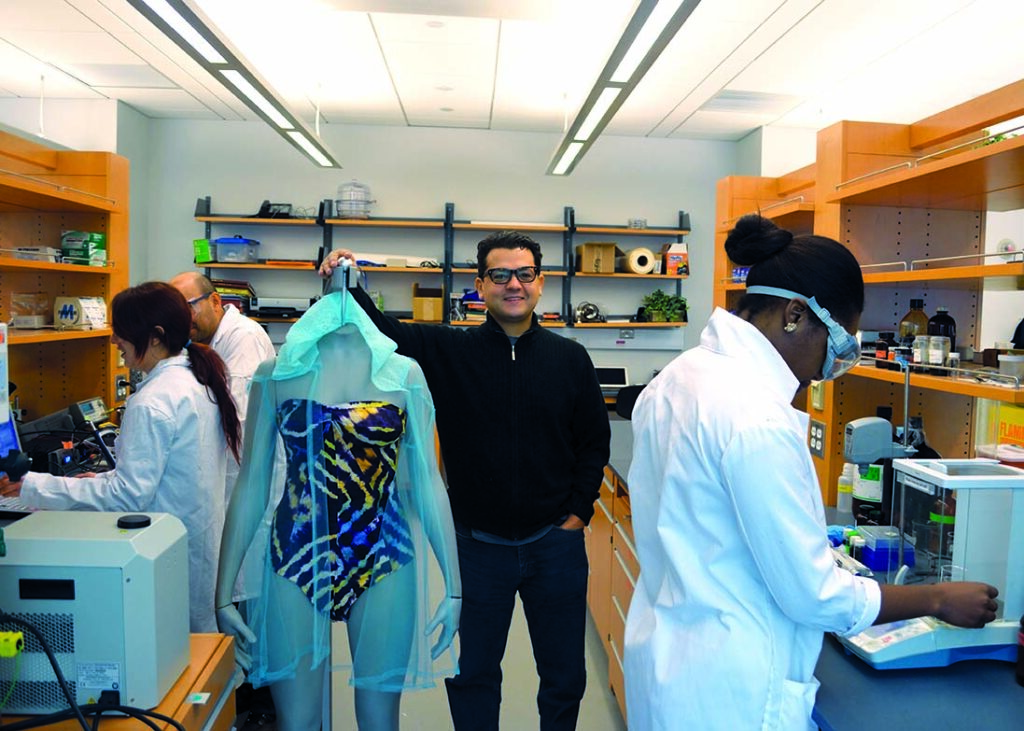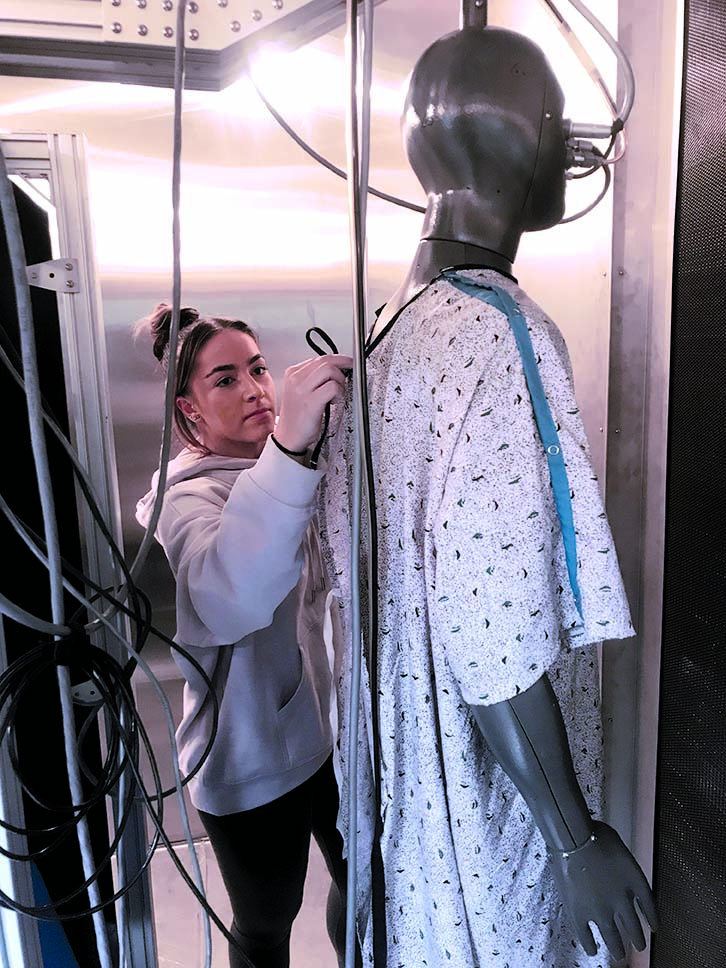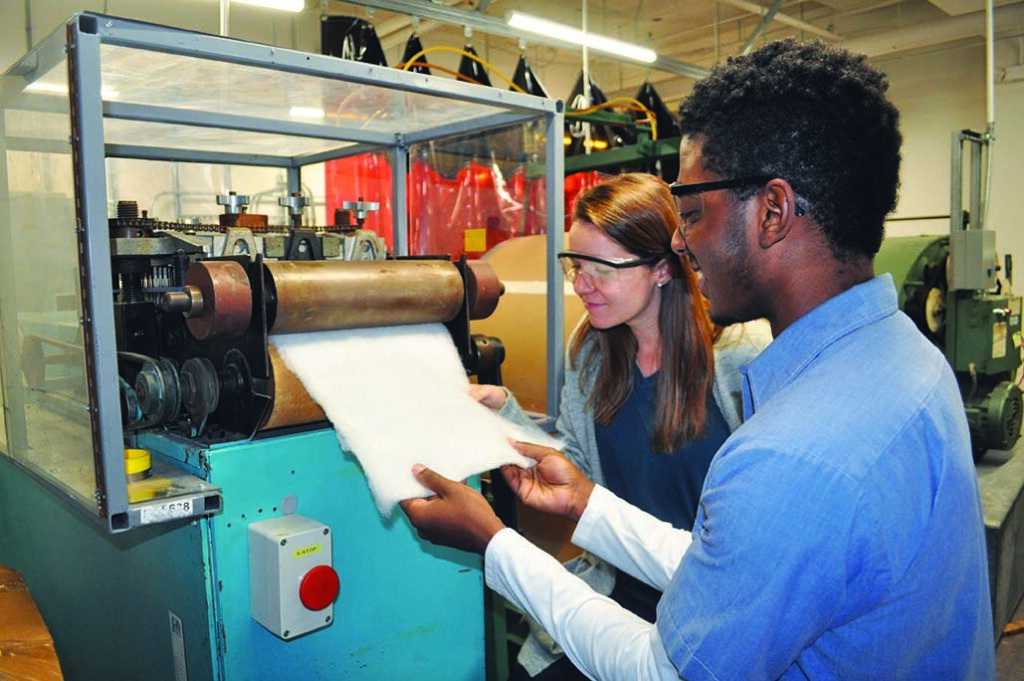
New textile products and processes are constantly being developed to meet the needs of the textile industry and other related industries, including aerospace, medicine, robotics, defense and more. Where do these new products and techniques originate?
Beyond the research done by textile manufacturers, many new products and ways of using textiles come from dedicated textile research programs or departments at universities and colleges across the United States. Here are some of the latest developments at these leading programs.
Wilson College of Textiles at North Carolina State University
The Wilson College of Textiles at North Carolina State University is the only college in the United States completely devoted to textiles. Its broad-ranging programs include the study of small molecules, large molecules, fibers, both woven and nonwoven fabrics, textile design and fashion design, textile management, and supply chain, explains Associate Dean for Research Xiangwu Zhang, Ph.D.
Much work has been done here developing human safety products. This includes protective garments for firefighters and the military, chemical and biological protective clothing, and face masks. The resulting gear is more comfortable, lighter weight, flexible, and easier to put on and take off than typical products. This saves lives because first responders and soldiers are more likely to use them correctly. Each garment is designed specifically for the needs of the mission.
A newer research area is wearables, or smart garments. These are textiles with sensors or other functionalities embedded that can hear, see, feel and respond.
The Wilson College of Textiles is leading a collaboration with the Technical University of Denmark to study a new way to make ammonia for fertilizer, for which they recently received a five-year $6.5 million grant from the Novo Nordisk Foundation. They are studying a method employing enzyme-soaked filters to capture nitrogen. Called the Biocatalyst Interactions with Gases, or BIG, Collaboration, the project involves using the naturally abundant, but difficult to harness, nitrogenase enzyme. This protein can convert nitrogen to ammonia at room temperature instead of the high heat (903 F/499 C) needed in existing conversion processes. If researchers can make this cleaner and less energy-intense process work on a large scale, it would revolutionize ammonia manufacturing, significantly reducing greenhouse gas emissions.

Texas Tech University Fiber and Biopolymer Research Institute
The Fiber and Biopolymer Research Institute (FBRI) is part of the Plant and Soil Science Department within the Davis College of Agricultural Sciences and Natural Resources at Texas Tech University. FBRI is an integral part of the history of the natural fibers industry of Texas, especially cotton. The institute’s activities focus on academic and professional education related to cotton fibers, fiber testing and evaluation, research, and textile processing. Within FBRI, four major laboratories equipped with state-of-the-art equipment and instrumentation enable cutting-edge research and testing of cotton fibers. They are the Ginning Lab, the Fiber Testing Lab, the Fiber/Textile Processing Lab and the Biopolymer Research Lab.
Research is ongoing at the FBRI to find uses for low-grade cotton fibers, cotton wastes or cotton linters lacking textile value, notes FBRI managing director Noureddine Abidi, Ph.D. A current project involves converting these low-grade cotton fibers into plastic films through dissolution of cotton cellulose and regeneration. The goal is for these cellulosic films to biodegrade in soil, making them a good future alternative to the nonbiodegradable polyethylene or polypropylene grocery bags used now.
University of California, Davis College of Engineering and Department of Design
University of California, Davis (UC Davis) conducts textile research in both the College of Engineering and the Department of Design. In the College of Engineering, researchers have been working on the development of biological and chemical protective wearable materials. These include chemical (fumigants and pesticides), biological (biocidal and antiviral), detoxifying and sensing fibers and fabrics for filters, face masks, and sensors. A current Centers for Disease Control/National Institute for Occupational Safety and Health (CDC/NIOSH)-funded project in the College of Engineering, in collaboration with Iowa State University and the University of Cincinnati, is looking at the development of biodegradable, reusable and antiviral face mask materials. The antiviral/biocidal functions are based on daylight-induced functions by using vitamins.
Led by Gozde Goncu-Berk, Ph.D., the UC Davis Department of Design’s WearLab focuses its research on the human-centered design of textile-based wearable products. These researchers look especially at products fostering health and well-being. This includes design for people with special needs, such as people with disabilities or those who suffer from chronic diseases, children, older adults people or athletes. WearLab explores possibilities of electronic textiles and smart clothing, using new material and digital fabrication technologies to facilitate design for a variety of body types, environmental and activity-based contexts.
Cornell University Department of Human Centered Design Fiber Science program
Cornell University’s Fiber Science program is housed in the Department of Human Centered Design. The faculty specializes in modifications at molecular, fiber and yarn stages with the potential for use at the fabric level. Research spans from creating quantum dots/nanoparticles (really small: 1.5–100 nanometers), to nanofiber mats (like face mask filters), to the more tangible textiles. Researchers here seek to solve real-world problems and sustainability issues by creating new functional materials for agriculture, energy, protection and sensing. Mosquito bed nets treated with insecticide are already being manufactured. Designed to protect people from malaria, the nets release insecticide when mosquitoes are most active, synchronizing the protection with each mosquito species.
Juan Hinestroza, Ph.D., directs the Textiles Nanotechnology Laboratory, where his Hinestroza Research Group explores the textile science/nanoscale science interface. The lab is developing new chemistries to use textile waste and discarded polyester textiles as raw material for multifunctional finishes, including antibacterial, nonflammable and wrinkle-resistant compounds. This innovation allows a more circular approach to raw materials use and minimizes the amount of textiles being sent to landfills. Other research focuses on innovative uses of cotton. This includes conducting electricity, capturing toxic chemical compounds in water and air, and responding to changes in temperature or environment. Cotton is also being used to capture human sweat to detect kidney disease, cancer and other illnesses.

Thomas Jefferson University School of Design & Engineering
What is now the textile program at Thomas Jefferson University School of Design & Engineering evolved from the first textile program in the United States. Founded in 1884 as Philadelphia Textile School by textile manufacturers who noticed a difference in the quality and variety of American textile products versus those from Europe, the school changed its name to the Philadelphia Textile Institute in 1941. In 1961, it became the Philadelphia College of Textiles and Science, then Philadelphia University in 1999, and finally Thomas Jefferson University in 2017 after a merger. The textile program has a long history of research, and some products developed there years ago are still used today. These include the first artificial artery, developed by professor Thomas Edman and student William Von Liebig, and a heat shield fabric that astronauts wear during spacewalks developed by professor J. Robert Wagner, which the university still produces.
Current research is wide-ranging. Hemp is being studied for varied applications, including bioplastics and textiles. Many researchers have connected with the university’s medical college to explore textile-based medical devices like improved operating room gowns. Some are studying recycling postindustrial and postconsumer textiles into new products. Other research includes looking at the effect of fabric construction on the generation of microfibers during washing, developing textile composites for aerospace applications, and examining natural materials for use in creating new dyes.
Jean Feingold is a freelance writer based in Gainesville, Fla.
 TEXTILES.ORG
TEXTILES.ORG


